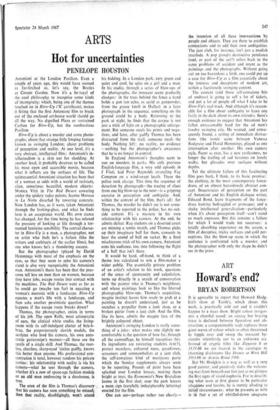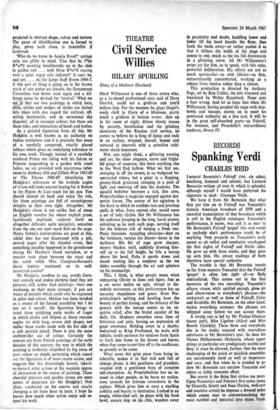Howard's end?
ART BRYAN ROBERTSON
It is agreeable to report that Howard Hodg- kin's show at Tooth's, which closes this week, is practically sold out and it couldn't happen to a nicer show. Bright colour invigor- ates a cheerful mood; an uneasy but bracing truce is declared between figuration and ab- straction; a companionable scale replaces those giant waves of colour which so often threatened to topple over and sweep the innocent by- stander relentlessly out to an unknown sea. Instead of cryptic titles like Ziggurat 8 or 24.11.66 we are treated in the catalogue to charming disclosures like Dinner at West Hill 1963-66 or Acacia Road 1966.
But Mr Hodgkin is a wag as well as a very good painter, and painlessly slides the welcom- ing mat from beneath our feet just as we glimpse the first signs of visual euphoria. For in describ- ing what seem at first glance to be particular situations and locales, he is merely alluding to initial circumstances; what he presents us with is ira fact a set of whittled-down anagrams projected in abstract shape, colour and texture. The game of identification one is forced to play, given such clues, is irresistible if irrelevant.
'Who do we know in Acacia Road?' springs only too glibly to mind. 'Can that be J'hn R*ss*ll standing bewilderedly up to the chin in golden rod . . . with Mme R*ss*ll musing over a quiet organ solo indoors?' It can't be,
and yet As for Large Staff Room 1964-7, if this sort of thing is going on in the brown murk of our senior art schools, the Summerson Committee had better meet again and a dif- fere t!t name be devised for 'tutorial.' What we see tin fact are two paintings in which bars, dabs, circles and wedges of circles are slotted into place with due regard for verticals off- setting horizontals, and an occasional shy diagonal, all in resonant colour; but there are those titles, and intimations of heads and bodies.
As a pointed digression from all this, Mr Hodgkin is well known as an authority on Indian miniatures and it is precisely that sense of a carefully composed, exactly placed tableau which gives an underlying substance to his own work. Though, instead of a carefully rendered Prince out riding with his falcon or Princess languishing in a garden with court ladies, we are provided with mysterious refer- ences to Anthony Hill and Gillain Wise 1963-66 or The Tilsons 1965-67. Identifying Mr Hodgkin's references or his multiple angles of vision will make anyone hoping for A Return to the Figure At Last reach for his gun. You should instead sit back and enjoy the ride, for these paintings are full of unambiguous delights in their own right. Altogether, Mr Hodgkin's vision is not unlike that of many an English novelist for whom explicit prose, fastidiously deployed, conjures forth an altogether different, quite unexplicit, sensation from the one our eyes reach first on the page. Henry Green's conversations are good at this, whilst who has not discovered with a jolt, several pages after the clouded event, that something peculiar happened in the greenhouse during Mr Hartley's bland narration, or a murder took place between the roast and the salad while Miss Compton-Burnett's sharp topiary continued on its well- mannered course?
Mr Hodgkin, needless to say, avoids litera- ture entirely and makes pictures (and they are pictures, still, rather than paintings—their one weakness, or their main strength, if you are weary of purism) which could only be expressed in paint and colour. Matisse has been invoked as a source of his formal sensibility but I do not see it myself: the figuration brings to mind those satisfying early works of Leger in which circles and ellipses at sharp staccato angles vie with long, severe slab shapes, not unlike those marks made with the flat side of a soft pointed pencil. There is also the same emblem-like use of colour. Certainly the sources are from French paintings of the early decades of this century; the way in which the painting is ruthlessly simplified by big areas of pure colour or simple patterning which cancel out the figuration is of more recent access, and suggests that this disarmingly honest, take-it- or-leave-it artist arrives at the requisite degree of abstraction in the course of painting. Those cheerful interiors and garden scenes are mere points of departure for Mr Hodgkin's Neil plays, conducted on the canvas and clearly changing a lot from hour to hour. I hope he knows how much other artists enjoy and re- spect his work.



































 Previous page
Previous page